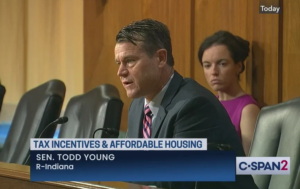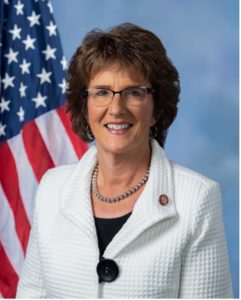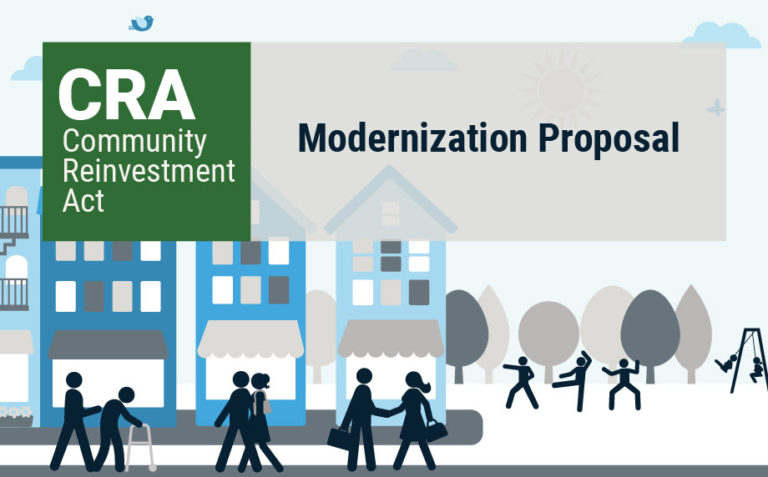
Chris Neary, Cinnaire’s Vice President for Policy, Research, and Advocacy, provides an update on the Inflation Reduction Act, CRA Reform, Federal Policy Items on Our Radar, and more in the latest issue of Policy Pulse.
Inflation Reduction Act on Track to be Signed Into Law
 Since Democrats won control of the Senate in January 2021, the big question dominating Washington was whether Democrats would be able to unite their different factions behind President Biden’s aggressive domestic spending plans. Congressional Democrats succeeded in enacting the American Rescue Plan Act and a bipartisan infrastructure bill, but with a razor-thin majority in both chambers, President Biden’s historically ambitious Build Back Better agenda remained a very late loose end and political albatross.
Since Democrats won control of the Senate in January 2021, the big question dominating Washington was whether Democrats would be able to unite their different factions behind President Biden’s aggressive domestic spending plans. Congressional Democrats succeeded in enacting the American Rescue Plan Act and a bipartisan infrastructure bill, but with a razor-thin majority in both chambers, President Biden’s historically ambitious Build Back Better agenda remained a very late loose end and political albatross.
Late last year, the Build Back Better agenda passed the House of Representatives but ran into a wall in the Senate, where it couldn’t attract the 50 votes needed to move forward. Senator Joe Manchin (D-WV) effectively declared Build Back Better dead when he announced that he couldn’t support the bill. Instead, he suggested that Democrats start from scratch to write a much narrower bill aimed at reining in costs for health care and prescription drugs, reducing the deficit through tax reform, and tackling climate change.
Even this narrower package looked very unlikely just a month ago when Senator Manchin appeared to quash any bill that included climate change and tax reform. A few weeks later, however, Senator Manchin and Senate Majority Leader Chuck Schumer made a surprise announcement that they had reached a deal after all. Despite some drama and politics, Democrats got their package through the Senate this past weekend. The bill, known as the Inflation Reduction Act, will spend an additional $433 billion, divided between climate change and energy provisions and additional health care subsidies, while reducing the deficit by $300 billion. The bill is financed by implementing a 15% corporate minimum tax, prescription drug pricing reform, beefed-up tax enforcement, and other provisions. It is poised to pass the House later this week.
With Senator Machin demanding a much narrower package than the original $1.7 trillion Build Back Better proposal, Democrats were forced to cut many priorities from the scope of the original package. Unfortunately, this meant that the previously proposed expansion of the Low-Income Housing Tax Credit, enactment of the Neighborhood Homes Credit, and $150 billion in additional affordable housing investments was left out of the final bill. There were some provisions in the Inflation Reduction Act that affect affordable housing, including items that support the compatibility of the Housing Credit with expanded energy credits and funding for HUD to improve energy and water efficiency of affordable housing.
Although major affordable housing provisions were not included in this measure, our Congressional champions will continue looking for opportunities to enact support for affordable housing for the rest of this year. The most likely vehicle will be the year-end tax extension bill, which is the typical vehicle for extending expired or expiring tax provisions, including the Housing Credit’s 12.5% allocation increase that expired at the end of last year and other popular tax provisions. Although the Housing Credit, New Markets Tax Credit, and the potential Neighborhood Homes Credit remain broadly supported on both sides of the aisle, sustained advocacy by our industry will be necessary for any additional support to be included in a year-end tax bill.
Cinnaire Comments on CRA Reform
The Community Reinvestment Act (CRA) – landmark law enacted by Congress in 1977 in response to redlining – remains an indispensable drivers of banks’ support for impactful affordable housing and community development projects benefitting low- and moderate-income (LMI) communities. The vast majority of investors in the Low-Income Housing Tax Credit, New Markets Tax Credit, and Community Development Financial Institutions (CDFIs) are driven by CRA.
Last week, Cinnaire submitted comments on a proposed rulemaking by the three main federal banking agencies to strengthen and modernize CRA rules. The proposed rule provides some long-overdue updates to the rules of the road for CRA investment, which have not been changed since 1995. In the proposed rule, the regulators aim to create more standard evaluations of banks’ performance, update where activities will count for credit, and provide more clarity on what activities count. Of note for our work, the regulators made clear that the Housing Credit and CDFI activities will be eligible.
At the same time, some elements of the proposed rule have caused concern in the affordable housing and community development industries, especially the elimination of the current separate investment test in favor of a combined Community Development financing test for banks. In our letter, we recommend that regulators retain a separate investment test or provide strong mitigating factors to ensure a robust level of investment in tax credit programs and CDFI lending. We also endorsed an even weighting for the proposed Retail and Community Development tests, called for regulators to address abuses in the Housing Credit program, and recommended other improvements.
If you have any questions on the proposed rule or our letter, please reach out to Chris Neary.
Treasury Makes Changes to Facilitate Use of Fiscal Recovery Funds for Affordable Housing
Responding to advocacy from Housing Finance Agencies (HFAs), Members of Congress, and industry groups, the Treasury Department recently published new guidance that will make it much easier for states and local governments to use funding from the State and Local Fiscal Recovery Fund (SLFRF) for affordable housing developments. The SLFRF, created by Congress under the American Rescue Plan Act, provided $350 billion to state and local governments to help them respond to the COVID-19 pandemic and its impacts.
Although affordable housing is an eligible use under SLFRF regulations, the program has proved very difficult to use in conjunction with Housing Credit properties. The new guidance will allow states and local governments to make long-term loans to affordable housing developments subject to certain conditions, as outlined by the National Council of State Housing Agencies, including a waiver of Qualified Contract rights.
To encourage state and local governments to utilize them, Treasury and the Department of Housing and Urban Development jointly published a How-To-Guide providing examples of how these flexibilities can help facilitate affordable housing development using multiple sources of federal funding.
Congressional Hearings Highlight Support for Tax Credit Programs
 Recently, the key tax-writing committees in the House and Senate held hearings focused on the affordable housing crisis. Both featured positive comments and bipartisan support for key programs like the Housing Credit and potential Neighborhood Homes Credit.
Recently, the key tax-writing committees in the House and Senate held hearings focused on the affordable housing crisis. Both featured positive comments and bipartisan support for key programs like the Housing Credit and potential Neighborhood Homes Credit.
During the Senate Finance Committee’s hearing, Senator Todd Young (R-IN), the lead Republican sponsor of the Affordable Housing Credit Improvement Act (AHCIA), asked the witnesses if they supported passage of the AHCIA. All five witnesses raised their hands. He also discussed his support for the Neighborhood Homes Investment Act.
At the hearing, Senator Tom Carper (D-DE) discussed the critical importance of affordable housing, mentioning Cinnaire’s work in Delaware as well as the work of our partners, NCALL and Habitat for Humanity.
Federal Policy Items on Our Radar
- Annual appropriations. With so much focus on new initiatives in Washington, it’s easy to lose sight of annual appropriations bills that set budgets for federal agencies. The current fiscal year expires on September 30th, just under two months away. Democrats in the House have passed some appropriations bills (including increases for HUD/USDA programs and the CDFI Fund). Meanwhile, the Democratic Chair of the Senate Appropriations Committee also released proposed bills on July 28th. At this point, these bills are just markers for negotiations. Democrats and Republicans must still reach an agreement on topline numbers. It remains unlikely that Congress will take action before the September 30th deadline, setting up federal agencies for a stopgap spending bill, known as Continuing Resolution (CR), that could run until after the mid-term elections. For more information on proposed spending levels for HUD and USDA housing programs, see the National Council of State Housing Agencies’ (NCSHA) budget chart here.
- Income averaging. In response to pressure from a bipartisan group of lawmakers (as well as HFAs and the affordable housing industry), the Treasury Department and the IRS have indicated that a final rule implementing income averaging for the Housing Credit program will be coming in September. Income averaging allows developers to meet affordability goals by taking the average income of a LIHTC property’s residents rather than requiring all residents to have incomes below the same threshold. Unfortunately, the IRS’s proposed regulations from 2020 essentially prevented the income averaging test from being used. The bipartisan group of lawmakers asked the IRS to use a rule that addressed stakeholders’ concerns about the previously proposed rule.
- Community development caucus and economic opportunity coalition launch. Demonstrating continued bipartisan support for community development, a new group of Senators announced the launch of a new Senate Community Development Finance Caucus. The same week, Vice President Kamala Harris announced a new Economic Opportunity Coalition made up of twenty-one major corporations and three foundations, as well as the collaboration of six federal agencies committed to aligning federal dollars flowing into communities with a history of disinvestment.
Mourning an Affordable Housing Champion
 Cinnaire mourns the tragic passing of Rep. Jackie Walorski (R-IN) and two of her staff members in a car accident last week. Rep. Walorski was an energetic and enthusiastic presence in Washington, demonstrating an ability to work across the aisle to help her Hoosier constituents. Her work in Washington supporting affordable housing, including as a champion for the Housing Credit program, will leave behind a lasting impact for her constituents and the communities we serve in Indiana.
Cinnaire mourns the tragic passing of Rep. Jackie Walorski (R-IN) and two of her staff members in a car accident last week. Rep. Walorski was an energetic and enthusiastic presence in Washington, demonstrating an ability to work across the aisle to help her Hoosier constituents. Her work in Washington supporting affordable housing, including as a champion for the Housing Credit program, will leave behind a lasting impact for her constituents and the communities we serve in Indiana.
More News, Good Reads & Resources
FACT SHEET: White House Summit on Building Lasting Eviction Prevention Reform
Harvard University’s Join Center for Housing Studies: State of the Nation’s Housing Report
NYTimes: The Extraordinary Wealth Created by the Pandemic Housing Market
Bloomberg: Does Affordable Housing Lower Property Values?
Washington Post: Rents are rising everywhere. See how much prices are up in your area.
Cinnaire’s Lucius Vassar: Use Federal Stimulus Funds to Counter Past Destructive Housing Policies
ShelterForce: New Models for Building Community Wealth
Rescue Act Funding Aims to Spur Affordable Housing in Delaware
About Cinnaire
Cinnaire is a non-profit financial partner that supports community and economic revitalization initiatives through creative investments, loans, and development services. Since 1993, Cinnaire has invested $4.7 billion to develop 811 housing communities in 10 states, providing 49,700 affordable apartment homes for more than 100,000 individuals and families, and has provided community development loans to support the creation/retention of more than 187,000 square feet of commercial, mixed-use, and community space. In its mission to change lives and transform neighborhoods into thriving communities, Cinnaire has helped to create or retain over 76,000 jobs and spurt $7.9 billion in economic impact. www.cinnaire.com










.png)
.jpg)




